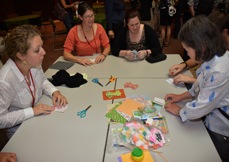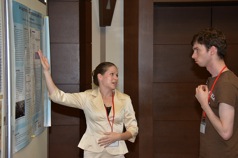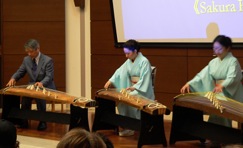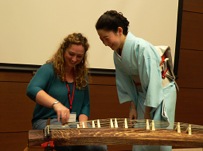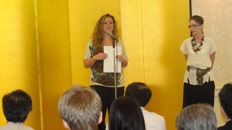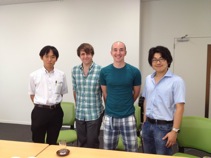Past Articles2013
JSPS Summer Program 2013
<Date> From Wednesday, June 12, to Tuesday, August 20, 2013
<Participants> 113 fellows in the JSPS Summer Program
Orientation
A total of 113 young pre- and post-doctoral researchers from the USA, the UK, France, Germany, and Canada came to Japan for the JSPS Summer Program 2013, which started on June 12, 2013. Despite their long trips from their countries, the 113 fellows seemed to be filled with anticipation for their coming two months of research activity in Japan.
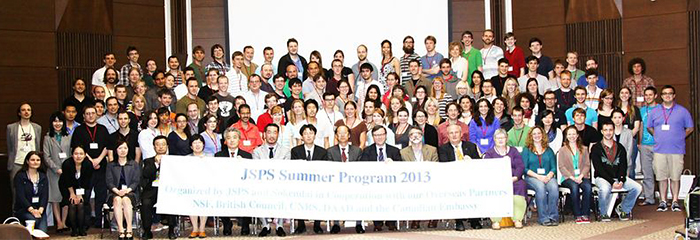
The Opening Ceremony began with an address by Dr. Takahata, the president of SOKENDAI. Many JSPS guests and Nominating Authorities also attended the ceremony. In the evening, many fellows enjoyed long conversations with their host researchers in Japan, the speaker of lectures of the next day's program, the faculty members in SOKENDAI, and the students who had participated in the SOKENDAI lecture. Thus, interaction among researchers from diverse fields and different cultures actively started.
On the second day, two special lectures were held on the leading edge of research in Japan. The lectures appeared to interest the fellows who plan to collaborate with Japanese colleagues for two months.
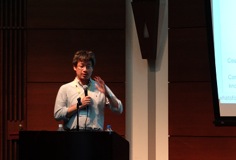
Dr. Minoru Yoneda from the University Museum of the University of Tokyo delivered an interesting lecture on the tradition of Japanese foods from an anthropological perspective. The familiar issue impressed fellows from the beginning of the lecture, and Dr. Yoneda introduced his challenging project on reconstructing the dietary habits of ancient people through a chemical analysis of human bones.
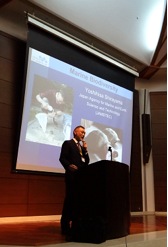
Subsequently, Dr. Yoshihisa Shirayama, Executive Director for Science, Japan Agency for Marine-Earth Science and Technology (JAMSTEC) gave a lecture on "Understanding and Protecting Marine Biodiversity," which featured several photographs of marine animals. Dr. Shirayama introduced a project carried out from 2000 to 2010 that aimed to understand the large unknown portion of animal phyla living in the ocean. In addition, he explained ocean acidification as posing a great threat to marine biodiversity. Fellows showed great interest on his lecture, especially two fellows who selected JAMSTEC as their host institution; his lecture must have had a significant impact on them.
During this orientation program, the fellows willingly attended Japanese language classes to learn various practical Japanese phrases. Their attitude demonstrated their enthusiasm for the upcoming two months of research activity. When they were introduced to aspects of Japanese culture (e.g., tea ceremonies, calligraphy, folding paper crafts, and kimonos), the exchange activity between the fellows and locals was covered by the local media; an article on the even was published in the June 14 issue of Kanagawa Shinbun.
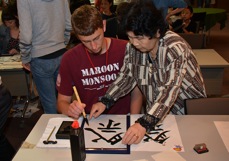

During the poster session, in which SOKENDAI students also participated, many positive opinions were exchanged. On the weekend, the fellows spent two nights with designated Japanese families, who gave them an opportunity to have memorable experiences. Some of them visited the Big Buddha in Kamakura and an onsen (hot spring) in Hakone; others stayed in Hayama to fish and surf. The parting between the families and fellows was considerably emotional and involved much hugging and tears on the part of children.
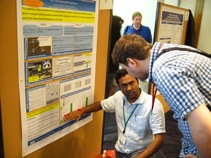
On June 17, Dr. Masateru Ando, a former professor at the Tokyo University of the Arts, discussed traditional Japanese music in his lecture. Dr. Ando expounded on Japanese traditional instruments. Six compositions were performed using a regular koto, a 17-stringed koto, a shakuhachi, and a shamisen. After the last performance, Sakura Henso Kyoku: The Cherry Blossoms Variation, enthusiastic fellows gave Dr. Ando and the other koto players a standing ovation. After the Q&A period, the fellows formed a long line to examine the koto, shakuhachi, and shamisen.
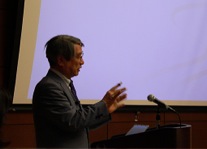
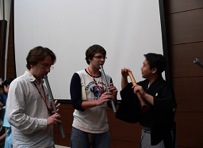
Although the orientation program was held during the rainy season, the weather turned fine on the last day (June 18), marking the conclusion of the week-long orientation in Hayama.
We hope this summer program was valuable for the fellows and that, with their youthful energy, they will continue to promote education at universities and research institutions and international academic exchanges in Japan.
Research Report Presentation & Farewell Party
On August 20, 2013, after spending two months doing research in host institutions throughou Japan, 113 young researchers from the USA, the UK, France, Germany, and Canada assembled at the Hotel Grand Palace in Kudanshita, Tokyo for the Research Report Presentation and Farewell Party. Six representative fellows of the JSPS Summer Program presented their research and reflected on their stay in Japan. After the presentations, the participants actively discussed their research fields and their summer experiences.
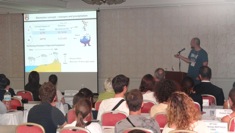
The farewell party following the presentations also included 14 host researchers and Dr. Shirayama (who had given an interesting lecture about marine biodiversity at the orientation in June) and Dr. Masateru Ando (who had given an excellent koto performance). A total of 170 participants grandly wrapped up a fruitful two months in Japan. Many fellows enjoyed not only this reunion but also the conversations about their research and cultural experiences in Japan. Their research results and remarkable growth demonstrated the significance of this fellowship program.
The followings messages are from some JSPS Summer Program fellows who stayed at SOKENDAI host institutions.
Yves Petinot
(NSF fellow from Columbia University at The Institute of Statistical Mathematics)
Q:What is the most impressive thing about this program?
A:I think the aspect of the program I have been the most impressed with is that it gives you the opportunity to be quickly integrated in a real-life Japanese environment (work, housing, etc.).
Even if this was for a (very!) short time, I did feel that I was getting an authentic experience as opposed to, say, if I had simply visited Japan as a tourist.
Q:How was the atmosphere of the laboratory in Japan compared with one in your country?
(What are the differences between the Japanese laboratory and your country's laboratory?)
A:The atmosphere in the laboratory was excellent and I always felt at ease when interacting with people there. The main difference I noticed was how palpable the hierarchy between the laboratory members was. Another clear difference, and this is something I was expecting to some extent, was that the notion of group is much more important here than in the US. In practice, this meant, a little bit to my surprise, that I very quickly felt as if I was an integral member of the lab.
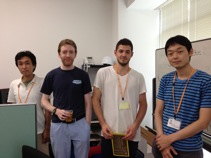
Jonathan ROOT
(NSF fellow from Boston University at The Institute of Statistical Mathematics)
Q:How was your research through this program?
A:I enjoyed my research experience and I thank my research host, Fukumizu- Sensei for everything.
Q:What did you think about orientation programs organized by SOKENDAI in Hayama?
For example, Japanese language classes or Japanese culture experience.
A:It was great, especially the home stay and the daily Japanese meals. The language classes were too broadly focused for those who knew no Japanese beforehand. I think they tried to cram in a little too much materials.
Richard VEALE
(NSF fellow from Indiana University at National Institute for Physiological Sciences)
Q:How was the atmosphere of the laboratory in Japan compared with one in your country?
(What are the differences between the Japanese laboratory and your country's laboratory?)
A:There are actually surprisingly few differences! The language is of course one of them. Also, the period of time during which people are in the lab is slightly different, but I think that is a difference in fields (computer science versus physiology). In computer science, we tend to show up later in the morning. I was impressed how late my colleagues in japan stayed even though they showed up so early in the morning!
Q:Would you give us a short message about this summer program?
A:I really enjoyed my experience and would like to come back soon! I think I will be applying for the JSPS postdoctoral fellowship and I hope do produce much more successful research with my excellent Japanese colleagues at NIPS/SOKENDAI!
Anja Batram
(DAAD fellow from Ruhr-University Bochum at the International Research Center for Japanese Studies, Kyoto)
Q:How did your research go in this program? Any good or bad things?
A: It was very good. I could access many materials I could not get in Germany quickly, so I could change, develop, and focus my research topic according to the current state of research in Japan. The library at my research center was very well stocked, which initially made things difficult for me because I quickly realized I had to change my approach (which is a good thing in a long-term perspective).
Q:What did you think about orientation programs organized by SOKENDAI in Hayama? For example, the classes on Japanese language and culture.
A:It was intensive, but very good. I could brush up my Japanese language skills during the language classes, get in touch with students at SOKENDAI, and meet young researchers from different countries and disciplines, which was all very pleasing.

